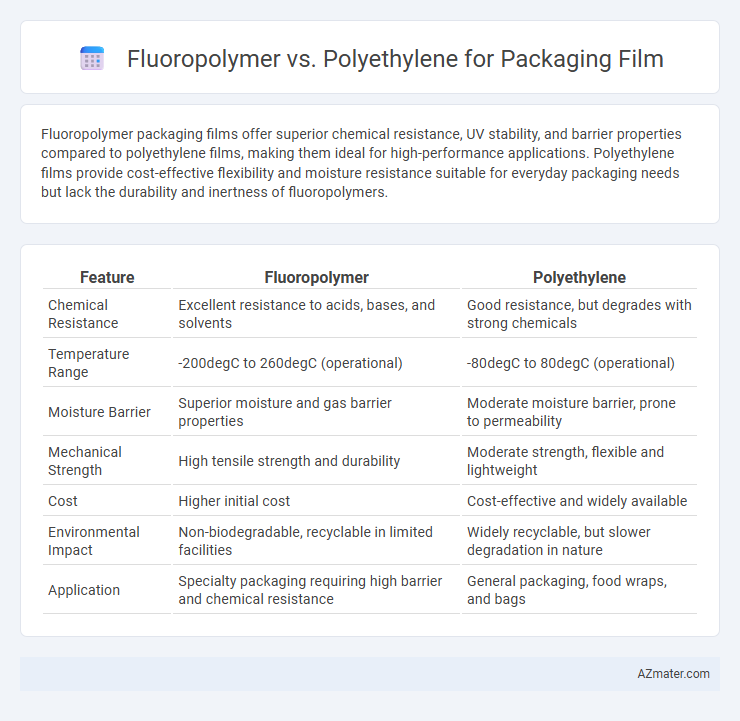Fluoropolymer packaging films offer superior chemical resistance, UV stability, and barrier properties compared to polyethylene films, making them ideal for high-performance applications. Polyethylene films provide cost-effective flexibility and moisture resistance suitable for everyday packaging needs but lack the durability and inertness of fluoropolymers.
Table of Comparison
| Feature | Fluoropolymer | Polyethylene |
|---|---|---|
| Chemical Resistance | Excellent resistance to acids, bases, and solvents | Good resistance, but degrades with strong chemicals |
| Temperature Range | -200degC to 260degC (operational) | -80degC to 80degC (operational) |
| Moisture Barrier | Superior moisture and gas barrier properties | Moderate moisture barrier, prone to permeability |
| Mechanical Strength | High tensile strength and durability | Moderate strength, flexible and lightweight |
| Cost | Higher initial cost | Cost-effective and widely available |
| Environmental Impact | Non-biodegradable, recyclable in limited facilities | Widely recyclable, but slower degradation in nature |
| Application | Specialty packaging requiring high barrier and chemical resistance | General packaging, food wraps, and bags |
Introduction to Packaging Films
Fluoropolymer packaging films provide superior chemical resistance, high thermal stability, and excellent barrier properties, making them ideal for protecting sensitive products in harsh environments. Polyethylene films, widely used due to their cost-effectiveness and flexibility, offer good moisture resistance but lower barrier performance against gases and chemicals. The choice between fluoropolymer and polyethylene films depends on specific packaging requirements such as durability, barrier efficiency, and exposure conditions.
Overview of Fluoropolymer Films
Fluoropolymer films offer exceptional chemical resistance, high temperature tolerance up to 260degC, and excellent barrier properties against oxygen, moisture, and solvents, making them ideal for demanding packaging applications. These films exhibit superior clarity, non-stick surfaces, and UV resistance compared to polyethylene, which typically provides moderate moisture barrier and lower chemical resistance. Due to their durability and inertness, fluoropolymer films are often used in pharmaceutical, food, and industrial packaging where contamination prevention and extended shelf life are critical.
Understanding Polyethylene Films
Polyethylene films, widely used in packaging, offer excellent clarity, flexibility, and moisture resistance, making them ideal for food and consumer goods packaging. Their cost-effectiveness and ease of processing contrast with fluoropolymer films, which provide superior chemical resistance and temperature stability but come at a higher price point. Understanding the balance between polyethylene's affordability and performance helps manufacturers select the optimal film type for specific packaging applications.
Physical and Mechanical Properties Comparison
Fluoropolymer films exhibit superior chemical resistance, higher temperature tolerance, and excellent barrier properties compared to polyethylene, making them ideal for demanding packaging applications. Polyethylene films offer greater flexibility, impact resistance, and lower cost, with physical properties such as lower tensile strength and melting point compared to fluoropolymers. Mechanical advantages of fluoropolymers include enhanced durability and dimensional stability under stress, whereas polyethylene provides better stretchability and ease of processing for lightweight packaging.
Barrier Properties: Moisture, Oxygen, and Chemical Resistance
Fluoropolymer packaging films exhibit superior barrier properties against moisture, oxygen, and chemicals compared to polyethylene films, making them ideal for sensitive food and pharmaceutical applications. The densely packed molecular structure of fluoropolymers provides exceptional resistance to permeation, significantly reducing oxidation and spoilage in packaged goods. Polyethylene films offer moderate moisture barrier but fall short in oxygen and chemical resistance, limiting their use to less demanding packaging environments.
Thermal Stability and Temperature Performance
Fluoropolymer packaging films exhibit superior thermal stability, maintaining integrity and barrier properties at temperatures exceeding 200degC, while polyethylene films typically degrade above 120degC. Fluoropolymers resist thermal oxidation and chemical attack, enhancing performance in high-temperature applications compared to polyethylene's susceptibility to melting and deformation. This makes fluoropolymer films ideal for sterilization processes and demanding environments where thermal resistance is critical.
Flexibility and Processability in Packaging Applications
Fluoropolymer films exhibit superior chemical resistance and temperature stability, offering excellent flexibility for dynamic packaging applications. Polyethylene films provide high processability with cost-effective extrusion and sealing, making them ideal for high-volume packaging production. Fluoropolymers are preferred when high-performance barrier properties and durability are crucial, while polyethylene excels in ease of processing and adaptability to various packaging formats.
Environmental Impact and Recyclability
Fluoropolymer packaging films exhibit superior chemical resistance but pose significant environmental challenges due to their persistence and difficulty in recycling, often requiring specialized facilities. Polyethylene films, widely used in packaging, offer better recyclability and lower environmental impact, supported by established recycling streams and biodegradability advancements. The preference for polyethylene aligns with sustainable packaging initiatives aiming to reduce plastic waste and promote circular economy principles.
Cost Analysis: Fluoropolymer vs Polyethylene
Fluoropolymer packaging films exhibit superior chemical resistance and temperature stability compared to polyethylene but come with significantly higher initial material costs, often 3 to 5 times greater. Polyethylene films offer cost-effective production and versatility, making them the preferred choice for large-scale packaging operations where budget constraints are critical. Evaluating total cost requires considering lifespan and performance benefits of fluoropolymers, especially for specialty packaging applications demanding durability and barrier protection.
Choosing the Right Packaging Film for Your Application
Fluoropolymer packaging films offer superior chemical resistance, low surface energy, and excellent barrier properties against gases and moisture, making them ideal for high-performance and specialty applications. Polyethylene films provide cost-effective, versatile options with good flexibility, moisture resistance, and ease of sealing, suitable for general packaging needs. Selecting the right film depends on factors such as product sensitivity, environmental exposure, and budget constraints to ensure optimal protection and performance.

Infographic: Fluoropolymer vs Polyethylene for Packaging Film
 azmater.com
azmater.com